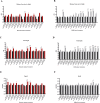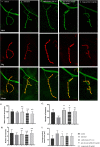Honeybee products and edible insect powders improve locomotive and learning abilities of Ubiquilin-knockdown Drosophila
- PMID: 32867756
- PMCID: PMC7457359
- DOI: 10.1186/s12906-020-03054-8
Honeybee products and edible insect powders improve locomotive and learning abilities of Ubiquilin-knockdown Drosophila
Abstract
Background: Mutations in the human Ubiquilin 2 gene are associated with neurodegenerative diseases such as amyotrophic lateral sclerosis (ALS) with or without frontotemporal dementia (FTD), the fatal neurodegenerative disease that progressively affected neuronal cells in both brain and spinal cord. There is currently no effective therapy for these diseases. Over the last decade, researchers have focused on the potential use of natural products especially in neurodegenerative studies. Insect products have been used as traditional medicines, however, scientific information is still lacking. Fruit fly is recently used as a model organism to investigate degenerative diseases related to the nervous system because it has a short life span and produces a large number of offspring.
Methods: The present study investigated the effects of honeybee products and edible insect powders on the locomotive and learning abilities, neuromuscular junctions (NMJs) structure, and reactive oxygen species (ROS) in larval brains of Ubiquilin- knockdown Drosophila.
Results: dUbqn knockdown flies showed defects in locomotive and learning abilities accompanied with structural defects in NMJs. The results obtained revealed that the recovery of locomotive defects was significantly greater in dUbqn knockdown flies fed with coffee honey from Apis cerana (1% v/v) or Apis dorsata melittin (0.5 μg/ml) or wasp powder (2 mg/ml) than that of in untreated dUbqn knockdown flies. Furthermore, dUbqn knockdown flies fed with coffee honey showed the partial rescue of structural defects in NMJs, improved learning ability, and reduced the accumulation of ROS caused by dUbqn depletion in the brain over the untreated group.
Conclusion: These results suggest that coffee honey from Apis cerana contains a neuroprotective agent that will contribute to the development of a novel treatment for ALS/FTD.
Keywords: Coffee honey; Edible insect; Honeybee product; Neuroprotective agent; Ubiquilin.
Conflict of interest statement
The authors declared that there are no competing interests.
Figures




Similar articles
-
A new Drosophila model of Ubiquilin knockdown shows the effect of impaired proteostasis on locomotive and learning abilities.Exp Cell Res. 2018 Jan 15;362(2):461-471. doi: 10.1016/j.yexcr.2017.12.010. Epub 2017 Dec 13. Exp Cell Res. 2018. PMID: 29247619
-
Depletion of Ubiquilin induces an augmentation in soluble ubiquitinated Drosophila TDP-43 to drive neurotoxicity in the fly.Biochim Biophys Acta Mol Basis Dis. 2018 Sep;1864(9 Pt B):3038-3049. doi: 10.1016/j.bbadis.2018.06.017. Epub 2018 Jun 21. Biochim Biophys Acta Mol Basis Dis. 2018. PMID: 29936333
-
The depletion of ubiquilin in Drosophila melanogaster disturbs neurochemical regulation to drive activity and behavioral deficits.Sci Rep. 2020 Mar 30;10(1):5689. doi: 10.1038/s41598-020-62520-y. Sci Rep. 2020. PMID: 32231214 Free PMC article.
-
Ubiquilin 2: a component of the ubiquitin-proteasome system with an emerging role in neurodegeneration.Int J Biochem Cell Biol. 2014 May;50:123-6. doi: 10.1016/j.biocel.2014.02.018. Epub 2014 Feb 28. Int J Biochem Cell Biol. 2014. PMID: 24589709 Review.
-
Biochemistry of insect learning: lessons from bees and flies.Insect Biochem Mol Biol. 1996 Apr;26(4):327-35. doi: 10.1016/0965-1748(95)00100-x. Insect Biochem Mol Biol. 1996. PMID: 8814781 Review.
Cited by
-
The synergistic extract of Zophobas atratus and Tenebrio molitor regulates neuroplasticity and oxidative stress in a scopolamine-induced cognitive impairment model.Front Aging Neurosci. 2025 Apr 23;17:1566621. doi: 10.3389/fnagi.2025.1566621. eCollection 2025. Front Aging Neurosci. 2025. PMID: 40336947 Free PMC article.
-
The Potential Use of Honey as a Neuroprotective Agent for the Management of Neurodegenerative Diseases.Nutrients. 2023 Mar 23;15(7):1558. doi: 10.3390/nu15071558. Nutrients. 2023. PMID: 37049399 Free PMC article. Review.
-
Epigenetic Regulation of ALS and CMT: A Lesson from Drosophila Models.Int J Mol Sci. 2021 Jan 6;22(2):491. doi: 10.3390/ijms22020491. Int J Mol Sci. 2021. PMID: 33419039 Free PMC article. Review.
-
Edible Insects: A New Sustainable Nutritional Resource Worth Promoting.Foods. 2023 Nov 9;12(22):4073. doi: 10.3390/foods12224073. Foods. 2023. PMID: 38002131 Free PMC article. Review.
-
Potential Therapeutic Benefits of Honey in Neurological Disorders: The Role of Polyphenols.Molecules. 2022 May 20;27(10):3297. doi: 10.3390/molecules27103297. Molecules. 2022. PMID: 35630774 Free PMC article. Review.
References
-
- Williams JP, Williams JR, Kirabo A, Chester D, Peterson M. Chapter 3 - nutrient content and health benefits of insects. In: Dossey AT, Morales-Ramos JA, Rojas MG, editors. Insects as sustainable food ingredients. San Diego: Academic; 2016. pp. 61–84.
-
- Rumpold BA, Schlüter OK. Nutritional composition and safety aspects of edible insects. Mol Nutr Food Res. 2013;57(5):802–823. - PubMed
-
- Fratellone P, Tsimis F, Fratellone G. Apitherapy products for medicinal use. J Altern Complement Med. 2016;22(12):423. - PubMed
MeSH terms
Substances
LinkOut - more resources
Full Text Sources
Medical
Molecular Biology Databases
Miscellaneous

